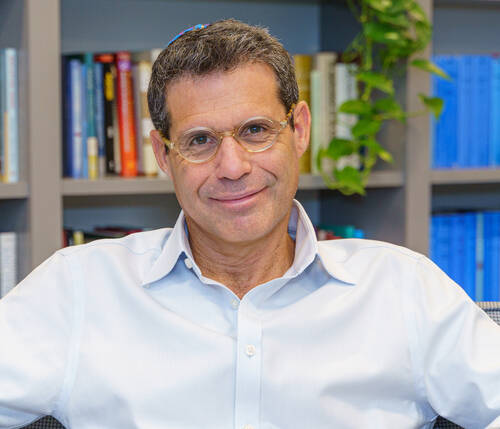Lessons from a Snowy Rooftop
Lessons from a Snowy Rooftop

One of the most important rabbis in our history was Hillel the Elder, who lived some 2,000 years ago. He was born in Babylon and moved to Israel as a young man, where he lived in poverty. The Talmud (Yoma, 35b) tells us the following story about this time in his life.
Hillel was a daily worker and earned a mere half-dinar per day. Half of this he spent on food for his family, and the other half to learn Torah. The cost of studying Torah at the Bet Midrash was a quarter-dinar per person, per day. One Friday Hillel could not find work and did not earn any money, so the guard of the Bet Midrash did not allow him in. He was so determined to continue his studies that he climbed onto the roof and leaned over the edge of the skylight so he could hear the words of Torah being taught. It was one of the coldest Shabbat evenings of the year. Hillel stayed up there all night and snow fell on him, covering him completely. When it was dawn, Shemaya, the teacher, looked up and saw the image of a man in the skylight. He and Avtalyon climbed to the roof and found Hillel almost frozen, covered with snow three cubits high! They carried him down and, although it is forbidden to light a flame on Shabbat, built a fire to warm him up. They said: “This man is worthy for us to desecrate Shabbat for him.”
I am puzzled by the end of the story, especially by what was not said there. I would expect the story to end with the Bet Midrash offering Hillel some financial arrangement to prevent him risking his life for the study of Torah in the future. But instead, we learn about Pikuach Nefesh (the obligation to save a life even at the expense of breaking the commandments), a concept that is well known and covered elsewhere. It seems as if Pikuach Nefesh was inserted as a diversion from the real question—can access to Jewish life be so costly that a person must choose between Torah and his family’s basic needs?
It has been 10 years since Temple Beth Am switched its financial model from dues, which is still the most common model in Jewish congregations, to Voluntary Financial Commitment (VFC). We didn’t do it out of fear that people may freeze on the Sanctuary roof trying to absorb some Yiddishkeit without paying. We did it because we believe that every Jew has the right to worship, study, and to belong to a Jewish community, regardless of their financial situation, and because we believe that no one should ever have to choose between practicing Judaism and providing for their family.
I am happy to report that our model has been working—because people do the right thing. When people join Temple Beth Am, they feel that they enter an unwritten covenant, according to which they give what they can. Some must give less than the suggested amount, but others who are financially fortunate, give more. VFC is not only a financial model, but is also the foundation for how a Jewish community should act at its best.
I want to thank all of you for helping us improve on Hillel’s situation by finding a way to strike the balance between financial stability and accessibility to Jewish life.
Tue, November 4 2025
13 Cheshvan 5786
Upcoming Events
-
Tuesday ,
NovNovember 4 , 2025Yoga with Yael
Tuesday, Nov 4th 10:00a to 11:00a
-
Tuesday ,
NovNovember 4 , 2025Choir
Tuesday, Nov 4th 6:30p to 7:30p
-
Wednesday ,
NovNovember 5 , 2025Mah Jongg
Wednesday, Nov 5th 1:00p to 4:00p
-
Wednesday ,
NovNovember 5 , 2025SH Board Meeting
Wednesday, Nov 5th 4:00p to 5:00p
-
Wednesday ,
NovNovember 5 , 2025Adult Education: Great Jewish Debates
Wednesday, Nov 5th 6:30p to 8:00p
-
Thursday ,
NovNovember 6 , 2025Canasta
Thursday, Nov 6th 1:00p to 3:30p
-
Friday ,
NovNovember 7 , 2025Kids Shabbat
Friday, Nov 7th 5:30p to 6:30p
-
Friday ,
NovNovember 7 , 2025Shabbat Service
Friday, Nov 7th 6:30p to 7:30p
-
Saturday ,
NovNovember 8 , 2025Men's Club Weekly Walk & Brunch
Shabbat, Nov 8th 9:30a to 11:00a
-
Sunday ,
NovNovember 9 , 2025Veteran's Day Breakfast
Sunday, Nov 9th 9:30a to 11:30a
Update this content.
Come Together
Something meaningful and dynamic is happening here at Temple Beth Am. It springs from the warmth of our welcome and the energy of our actions. We call it: Kulanu - All of Us Together.
Join UsUpcoming Events
-
Tuesday ,
NovNovember 4 , 2025Yoga with Yael
Tuesday, Nov 4th 10:00a to 11:00a
-
Tuesday ,
NovNovember 4 , 2025Choir
Tuesday, Nov 4th 6:30p to 7:30p
-
Wednesday ,
NovNovember 5 , 2025Mah Jongg
Wednesday, Nov 5th 1:00p to 4:00p
-
Wednesday ,
NovNovember 5 , 2025SH Board Meeting
Wednesday, Nov 5th 4:00p to 5:00p
-
Wednesday ,
NovNovember 5 , 2025Adult Education: Great Jewish Debates
Wednesday, Nov 5th 6:30p to 8:00p
Privacy Settings | Privacy Policy | Member Terms
©2025 All rights reserved. Find out more about ShulCloud

